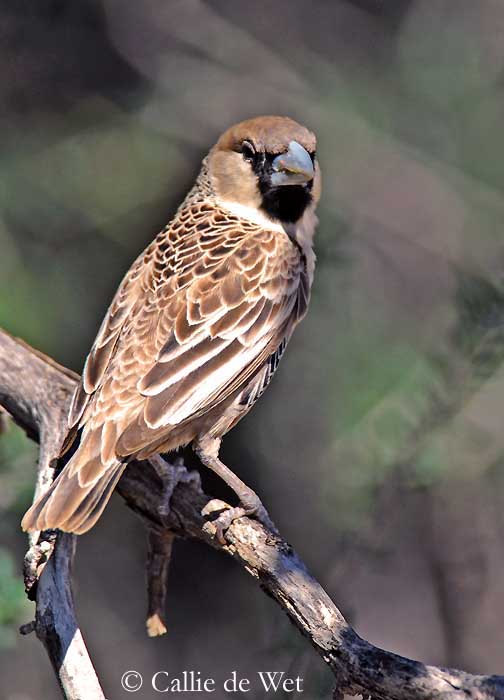
Sociable Weaver
Philetairus socius
Passeriforme order – Ploceidae Family
BIOMETRICS :
Length: 14 cm ; Weight: 26 à 30 g
DESCRIPTION:
In the field, Sociable Weaver appears as a buff brown bird and we can see its conspicuous black chin and its whitish underparts.

Sociable Weaver has blackish back and wings, and buff brown rump. We can see a scaled pattern on back, nape and wings coverts. Tail is blackish and the buff median tail feathers are very neat in flight.
Underparts are buff white. Flanks present scaly pattern forming a patch of bold black chevrons.
Crown is buff brown and nape shows scaled pattern. Chin is black, and this colour extends to lores forming a black mask. Cheeks are whitish.
Conical, strong bill is bluish grey. Eyes are dark brown. Legs and feet are bluish grey.
Both sexes are similar.
Juvenile is duller than adults. It lacks the black face mask, and black chevrons on flanks are faint. Bill is pale brown. It reaches its adult plumage at about 16 to 18 weeks of age.
There are four subspecies:
Philetairus socius eremnus, living in the Oranje River Valley;
Philetairus socius socius, from S. Kalahari in NW of Northern Cape and S. Namibia;
Philetairus socius xericus, living in Namibian escarpments;
Philetairus socius geminus, from Etosha and S. Owambo areas in N. Namibia. This one is separated from subspecies further north.
VOICE: SOUNDS BY XENO-CANTO
Sociable Weaver utters a chattering “chicker-chicker” call, often given in flight.
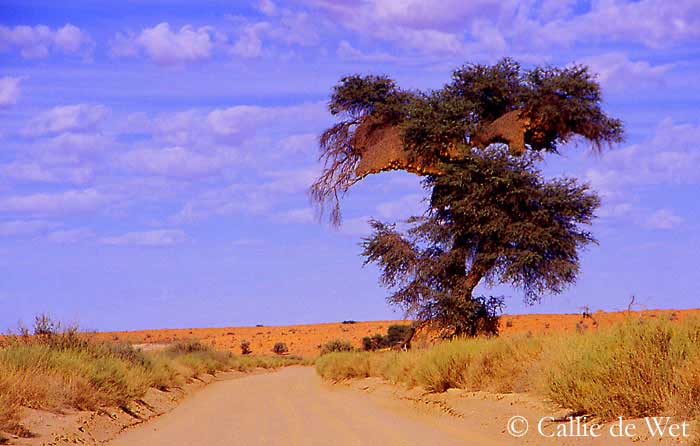
HABITAT:
Sociable Weaver lives in dry thornveld and broad-leafed woodlands. It needs areas of open savannah grasslands with large trees for nesting, mainly Acacia trees.
RANGE:
Sociable Weaver is an endemic species to South Africa. Range is located in Northern Cape Province and southern Namibia. Most of the populations live in the Kalahari Desert. Sociable Weavers are resident in their range.
BEHAVIOUR:
Sociable Weaver skitters along the ground, searching for insects and seeds. It usually forages in flocks. This species is highly gregarious all year round and it is very interesting to study its nesting behaviour.
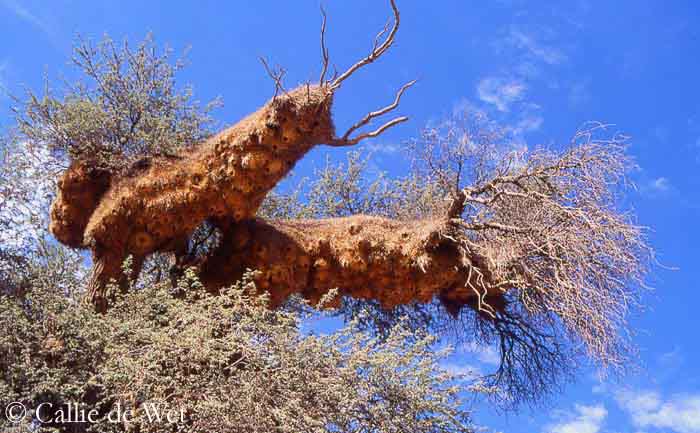
Most of birds’ species build nest for only one breeding season, but Sociable Weavers use and maintain the nests throughout the year. They nest in colonies of up to 10 to 400-500 birds. They weave one huge nest for the entire colony. Nest is massive, as a huge apartment block occupied by several tens of families all year round.
At some distance, this huge construction looks like a haystack hanging in large tree or telephone pole. It may size up to 4 metres high and 7 metres of length. Looking under the nest, we can see the entrances to chambers, as “bee’s honeycombs”.
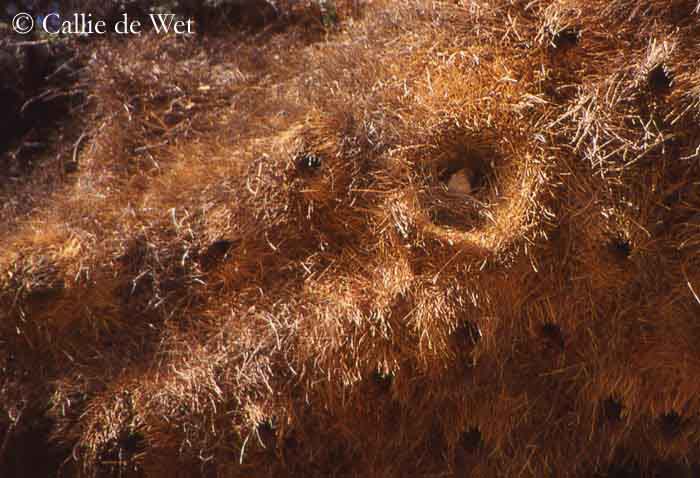
Nest entrances of chambers are tunnels of up to 25 cm long and 7 cm wide. Then, there is the round nesting chamber, of about 10 to 15 cm in diameter.
Sociable Weaver uses different materials for each purpose. This huge nest is covered by a roof made with large twigs and stems, placed at an angle, pointing downwards, until the vertical entrance driving to each chamber. Grasses are pushed into the structure until it firmly secured. These sharp spikes of straw protect the entrances from predators.
Nesting chamber is entirely lined with fine, soft materials, such as fur, cotton or fluff.
Usually, the nesting tree (or pole) has a long, smooth trunk and high branches, in order to discourage predators such as tree snake species. Only the Cape Cobra may enter and explore nests, for chicks and eggs.
Sociable Weavers have to care their large nest constantly, adding materials to keep it intact.
This type of structure allows protecting against cold winter nights and heat of summer, in the harsh climate of the Kalahari Desert.

Other interesting fact, Sociable Weaver’s nest accommodates several “guests” such as the South African Pygmy Falcon, which may nest side to side with the Weavers. Other species of barbets, chats, finches, tits and lovebirds enjoy the cosy nesting chambers. But large birds such as vultures, owls and eagles may roost on the nest roof and even build their nest on the roof, using it as platform or support.
Such numbers of residents is a kind of protection, with more eyes watching for danger.
Some huge nests weight several tons and become so heavy they may knock down the supporting tree or pole. Some nests have lasted over an entire century.
FLIGHT:
Sociable Weaver is always in motion, skittering along the ground for food.
REPRODUCTION:
Sociable Weaver seems to breed at any time of the year, starting by rainfalls and lasting as long as food resources are abundant. This species may produce 4 consecutive broods, meaning that eggs and chicks are present long time after start of rainfalls. Breeding season may be more or less important, according to the place.
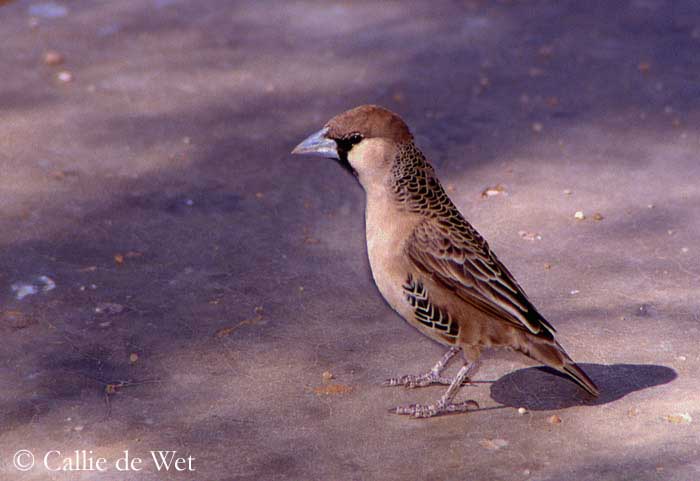
Within the huge colony nest, breeding pair lines the cup in its nest chamber with soft grass flowers and fine materials, and they create a firm ridge at the lip of the cup with green grass, in order to keep eggs from rolling out.
Female lays 2 to 6 eggs. Incubation lasts about 12 to 14 days. Altricial chicks are fed by both parents and helpers. Previous juvenile provide food to the younger, and parents may also provide food for their neighbours’ young. Young fledge at about 14 to 16 days after hatching.
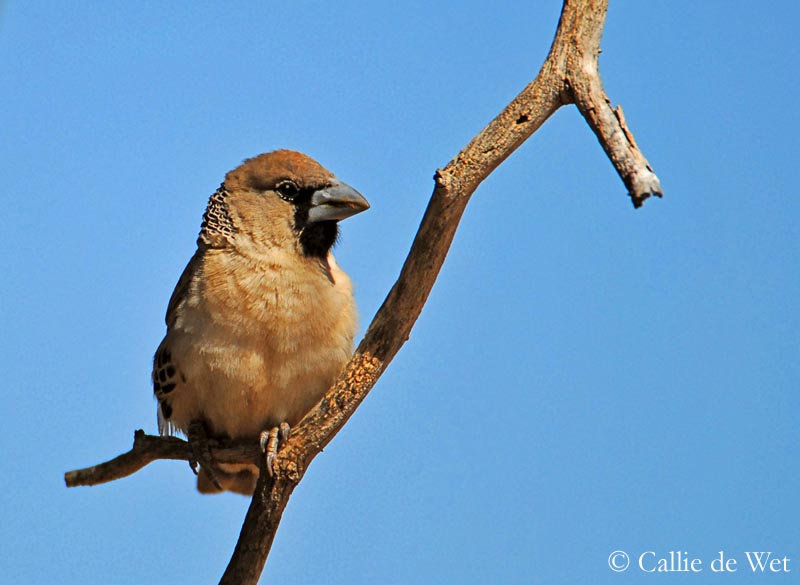
DIET:
Sociable Weaver feeds mainly on insects and seeds. Their favourite food is harvester termites which provide them moisture for drink. Sociable Weavers don’t drink a lot, finding water in their food.
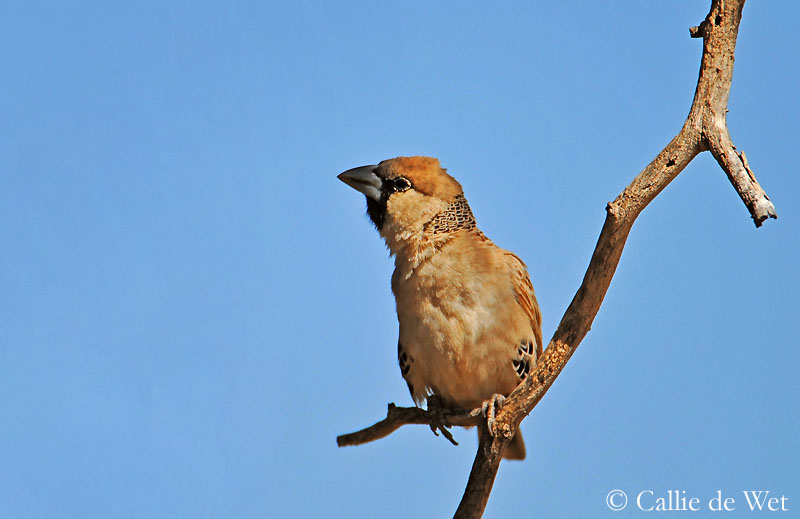
PROTECTION/ THREATS/ STATUS:
Sociable Weaver populations have expanded in distribution with the use of telephone poles and other artificial and man made structures as nest site supports. Sociable Weavers conservation statuses seem secure.
Fr: Républicain social
All : Siedelweber
Esp : Tejedor Sociable
Ital : Passero repubblicano
Nd : Republikeinwever
Russe : Обыкновенный общественный ткач
Photographs by Callie de Wet
GALLERY
Text by Nicole Bouglouan
Sources:
L’ENCYCLOPEDIE MONDIALE DES OISEAUX - Dr Christopher M. Perrins - BORDAS - ISBN: 2040185607
BIRDS OF AFRICA SOUTH OF THE SAHARA by Ian Sinclair and Peter Ryan - Princeton University Press Princeton and Oxford - ISBN: 0691118159
SORA Searchable Ornithological Research Archive (Blair O. Wolf)
Birds of Southern Africa (Tony Roocroft)